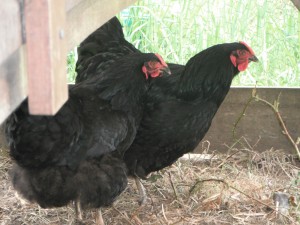Chicken Tractors and Worm Cans
I hate having to throw anything away. I recycle everything that is allowable in the co-mingling recycling bin and save up anything else that can be dropped off at a convenient location. I try to buy only what my family will use, but inevitably food spoils and must be discarded. I feel not so wasteful when I feed kitchen scraps to my chickens or my worms.
A “chicken tractor” is a portable chicken coop, designed to put chickens to work weeding and fertilizing areas of your garden. The best part is you get fresh eggs (and meat, if desired)—no roosters needed! Hens are easy to care for; they can be given food scraps such as stale bread and cereals, vegetables and fruits (they won’t eat rinds); they eat cheese too; and recycle eggshells! You should buy “layer crumble (or pellet)” for supplemental feed. And of course, make sure they have fresh water. The disadvantage of having chickens is that they are messy; like all birds, they poop everywhere. If you don’t want poopy eggs, you need to clean out nest boxes frequently and put in fresh bedding. Animal manure attracts flies; moving the chickens frequently reduces manure build up. After you move your chicken tractor the area can be tilled, raked out and prepared for planting. Chickens don’t discriminate between weeds and your prize plants—so keep them away from plants you don’t want eaten or the soil scratched up around. Your chicken tractor also needs to be predator proof. I never know for sure what gets our chickens at night— a chicken can be dragged through a hole as small as a softball and all that’s left the next day are some feathers! You may think a pastoral scene of wandering chickens would be picturesque, but unpenned chickens aren’t safe and are likely to eat or tear up your garden plants.
I inherited a “Can-o-Worms” worm composter from a neighbor. The Can-o-Worms is convenient because you can separate the finished, older compost more easily and drain away the “compost tea” (which can be used to water plants). To be a successful worm wrangler, you just need to make sure you don’t layer in the food scraps too thickly. You need to maintain the right balance of moisture and aeration. Worms can be purchased, or get them from a friend or a local organization. Start by placing worms in a bed of compost (or coconut fiber). Add a layer of food scraps and cover with moistened, shredded (non-colored) newspaper (or fallen leaves). Continue layering food scraps and newspaper in the following days and weeks until layer is full; then start again in the next section allowing worms to migrate up from the older section to the new. Worms love vegetable scraps and fruit rinds — especially melons! I like the fragrance of orange peels. Almost any plant product can be put into a worm bin: coffee grounds, tea bags, dryer lint (from natural fibers), sunflower and nut shells. . . as long as you don’t load up too much green or wet material and woody material is small. Leftover tomato, melon and other seeds often sprout in soil made from worm compost. The biggest drawback is that annoying fruit flies are attracted to the bin.
Between my chickens and my worms the only kitchen scraps that I throw out are: 1) meat and fish bones and scraps; 2) some dairy products; and 3) fats and grease. (I even use old cooking oil for making laundry soap —or my husband uses it instead of diesel!).
(This article was first published in the Peninsula Gateway on February 10, 2010.)



